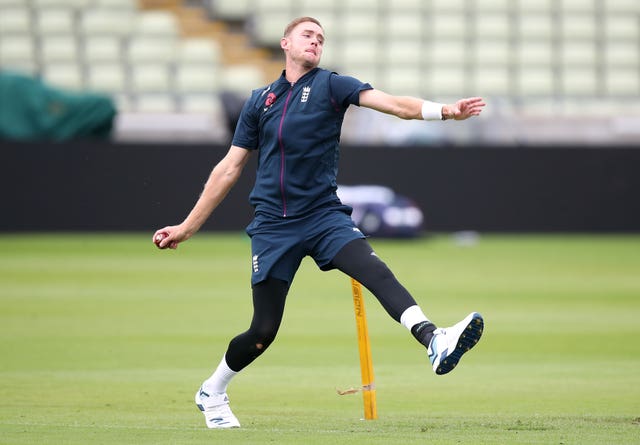England cricketers will return to individual training from next week with a reassurance that safety protocols should make the sessions less risky than a trip to the supermarket.
After assessing Government guidance the England and Wales Cricket Board has designed a programme for around 30 male players to work on personalised regimes alongside one coach and one physio at a time, with up to 11 first-class grounds being utilised.
Bowlers will be the first into action and are expected to begin work on Wednesday, some with an additional strength and conditioning specialist present, with batsmen following a fortnight later.

As well as being outdoors, weather allowing, players and staff will observe social-distancing advice, take temperature tests on arrival while any injury treatment will only be undertaken with full personal protective equipment in use.
The measures are the next step towards the governing body's hopes of hosting international matches in July, though that ambition is contingent on a number of other factors.
As ever the health of all involved remains the top priority and Ashley Giles, director of men's cricket at the ECB, insists the highest standards are being met.
"To be clear, we will only train and potentially play cricket behind closed doors if we know it is absolutely safe to do so and is fully supported by the Government," he said.
"It is very clear that this is individual skills-based training so in many ways we should be able to get control of the environment right, so it's safer to go back to practice than it is to go to the supermarket.
"In this first phase, this should be a safer environment than going about daily life as it is – such as shopping. We are also outside where we know the risks are far less. We will certainly carry out the right risk assessments at the venues we use, we will make sure all the staff are trained, that we have the right equipment including PPE so will make sure everything is there for the guys to go about their business as safely as possible."
The training group has been chosen with a focus on red-ball cricket, and a Test series against the West Indies, but does not constitute a squad at this stage. As well as the centrally-contracted regulars there are also likely to be uncapped county players involved, with a larger group needed to populate any subsequent training camps or behind-closed-doors series.

Giles, national selector Ed Smith, performance director Mo Bobat and head coach Chris Silverwood were all involved in putting together the names, which are due to be announced early next week.
Any chosen players who are not centrally contracted will be temporarily moved to the ECB payroll, with all the majority of professionals currently stood down on the coronavirus job retention scheme. The same is true of a small number of domestic coaches and backroom staff, who will be needed to bolster the current international team.
Giles said: "We want to work with the counties. If there are costs that we can help with we will. There are a lot of players on furlough at the moment.
"And we're definitely going to have to mobilise the help of some of our network coaches, which is great. There is a cost to putting cricket on but there is a much bigger cost to not playing cricket at the moment."
Giles also moved to clarify what will be asked of an England squad should things progress towards a full fixture list.
The idea of keeping the England group together in isolation for up to nine weeks had been discussed and, although at least some would be willing, there is an understanding that it may be unfair or undesirable to stay away from families for so long.
"We have to look at ways where we can get players home. It isn't normal," Giles explained.
"Whilst these guys are used to touring for perhaps three or four months, these aren't normal conditions. With what's going on through the country people will want to see families, they are going to want to get home and see their kids, so we have to look at ways we can make that happen.
"I could sit here and say those are the protocols and we are going to stick to them but it isn't realistic. We are going to have to find ways where we can get players out of the environment.
"We are either going to have to be smart with how we can get guys in and out of that environment – testing, tracing and tracking will have changed a hell of a lot by then and that should help us. Otherwise we are going to have to be smart with selection."
/https%3A%2F%2Fsportsmole-media-prod.s3.gra.io.cloud.ovh.net%2F19%2F02%2Fashley-giles.jpg)
 England
England
/https%3A%2F%2Fsportsmole-media-prod.s3.gra.io.cloud.ovh.net%2Fuploads%2F2025%2F11%2Fimago1067466609-690b33b9629cc927791165.jpg)
/https%3A%2F%2Fsportsmole-media-prod.s3.gra.io.cloud.ovh.net%2Fuploads%2F2025%2F07%2Fimago1064533006-6889f0b32d896043262124.jpg)
/https%3A%2F%2Fsportsmole-media-prod.s3.gra.io.cloud.ovh.net%2Fuploads%2F2025%2F09%2Fjacob-bethell-68bf07a19a680487490133.jpg)
/https%3A%2F%2Fsportsmole-media-prod.s3.gra.io.cloud.ovh.net%2Fuploads%2F2025%2F08%2Fimago1064776089-68909748a2cca644295636.jpg)
/https%3A%2F%2Fsportsmole-media-prod.s3.gra.io.cloud.ovh.net%2Fuploads%2F2025%2F11%2Fimago1069426574-6921890c1fa15979871066.jpg)
/https%3A%2F%2Fsportsmole-media-prod.s3.gra.io.cloud.ovh.net%2Fuploads%2F2025%2F11%2Fimago1069398963-69203b57b0924331078033.jpg)
/https%3A%2F%2Fsportsmole-media-prod.s3.gra.io.cloud.ovh.net%2Fuploads%2F2025%2F11%2Fjoe-root-691e64694f32a806526367.jpg)
/https%3A%2F%2Fsportsmole-media-prod.s3.gra.io.cloud.ovh.net%2Fuploads%2F2025%2F11%2Fsmith-691e5bc238211304088798.jpg)